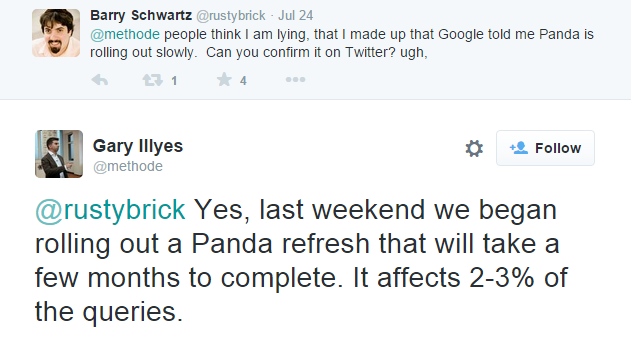5 Ground Rules for Creating Google Panda Friendly Content
After the release of Panda 4.2 last July 18 (2015), a lot of SEO folks are expecting to see quality websites to finally overrank sites with poor content.
For three weeks, we saw significant improvements with search rankings, and somehow justified what Gary Illyes confirmed on Twitter regarding the Panda update.
“It affects 2-3% of the queries.” -Gary Illyes
Surprisingly though, after more than three weeks since the update, the effects seemed to be reversing.
In a post by Barry Schwartz just last week, he said that there’s a great possibility of Panda 4.2’s u-turn.
The vertical red line is the Panda release and the horizontal line is showing Barry’s pre-Panda 4.2 Google organic traffic and how it returned to the same level.
But regardless of the possible reverse, the concern now lies in how we can keep from following Google’s guidelines and avoid being penalized – something that will keep us safe until they release 4.3, 4.4, 4.5 and so on – and whether a reverse happens or not.
What is the Panda Update for?
Panda was created with a sole purpose: to tell webmasters to create quality content. But what is quality content for Google? I mean really, it’s so easy to ask someone to write something of quality, but without stepping into Google’s mindset, it will be a bit hard to follow their guidelines.
5 Ground Rules for Creating Google Panda Friendly Content
To keep you inside Panda’s safe zone, here are some ground rules to consider, backed by Google Webmaster Central Blog.
1. Well edited content
I’ve seen so many great topics online. There were data presented and even support from experts, and yet they were written in a very sloppy manner.
There were typographical errors and wrong spacing or format. In short, it’s not well edited.
But even great writers need editors. And it’s not just for the sole purpose of making Google love you, but also because of the fact that readers don’t like seeing errors.
Here are some questions presented by the Google Webmaster Central Blog that you should ask when publishing content.
- Does this article have spelling, stylistic, or factual errors?
- Was the article edited well, or does it appear sloppy or hastily produced?
2. Unique content
With tons of content available online, it’s hard to create something that will be of value and at the same time unique. But being unique doesn’t always mean you have to come up with topics that you originally discovered (of course it’ll be great if you can produce something like that). Because let’s admit it, there are answers to almost all of our questions, and almost all topics that we could think of are already in the search results page. It’s hard to be truly original.
Good thing is that uniqueness can also be about looking at different angles of an existing content, or by making an existing content into a better one by adding up new information. Being unique also means that you have no duplicate content.
These questions from Google should guide you with creating unique content:
- Does the site have duplicate, overlapping, or redundant articles on the same or similar topics with slightly different keyword variations?
- Does the article provide original content or information, original reporting, original research, or original analysis?
- Does this article contain insightful analysis or interesting information that is beyond obvious?
3. Trustworthy content
It’s hard to convince readers to believe in you if you’re not presenting facts, or at least quoting an expert to support your statement, unless you’re the expert.
It is also best for your website to have a certain focus or niche. It doesn’t just help you build your brand focus, it also makes you an expert or an avenue for certain topics.
When building a website, or creating content, ask yourself these questions:
- Would you trust the information presented in this article?
- Is this article written by an expert or enthusiast who knows the topic well, or is it more shallow in nature?
- Is the site a recognized authority on its topic?
- For a health related query, would you trust information from this site?
- Would you recognize this site as an authoritative source when mentioned by name?
4. Focused content
Part of producing quality content is making sure that your readers have enough space and clarity to focus and fully understand what your article is all about. And to do that, you have to make sure that your website doesn’t have too many elements that might distract your readers.
Ask yourself:
- Does this article have an excessive amount of ads that distract from or interfere with the main content?
- Would users complain when they see pages from this site?
Too much elements like excessive ads can not only distract users, but can also affect your site speed. Give importance to user-experience.
5. Thick and substantial content
In one of Moz’s Whiteboard Friday, Rand discussed the importance of quality and thickness of content. If you have too many pages with thin content, there is a big possibility that Google will not just focus on your low quality pages (or hurt your low quality pages), but will look at your whole website, either to lower your rankings or worst to penalize you.
“You know what? You’re tipping over the balance of what a high quality site looks like to us. We see too many low quality pages on the site, and therefore we’re not just going to hurt the ranking ability of the low quality pages, we’re going to hurt the whole site.” -Rand Fishkin
To guide you with crafting not just thick but also substantial content, consider these questions and guidelines from Google:
- Does the page provide substantial value when compared to other pages in search results?
- How much quality control is done on content?
- Does the article describe both sides of a story?
- Does this article provide a complete or comprehensive description of the topic?
- Does this article contain insightful analysis or interesting information that is beyond obvious?
- Is this the sort of page you’d want to bookmark, share with a friend, or recommend?
- Would you expect to see this article in a printed magazine, encyclopedia or book?
- Are the articles short, unsubstantial, or otherwise lacking in helpful specifics?
- Are the pages produced with great care and attention to detail vs. less attention to detail?
Now you’re ready to face Panda!
Whatever the algorithm update may be, it’s good to keep an ear out for news. Be alert, and consider reading guidelines from Google and other search engines – but don’t box yourself.
Remember that these are just guidelines, and you’re still, and always free to test all you want – whatever will work best for you.
For a full list of Google Webmasters Guidelines, click here.


